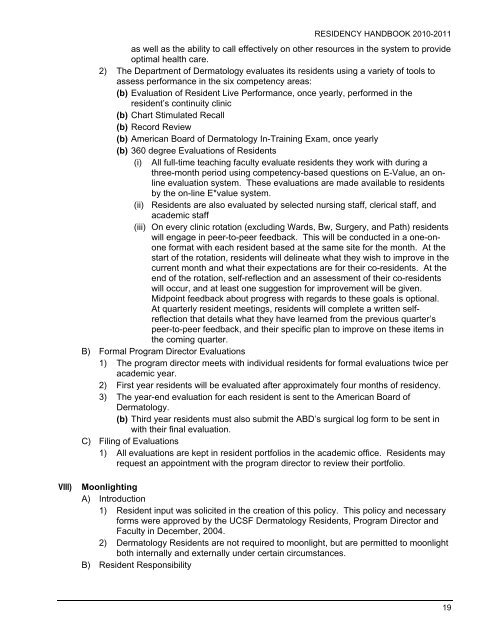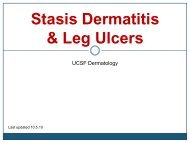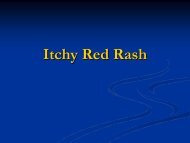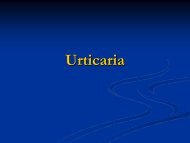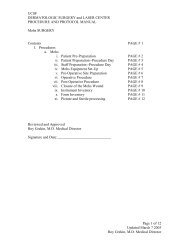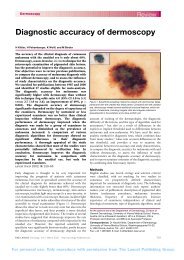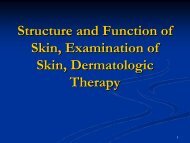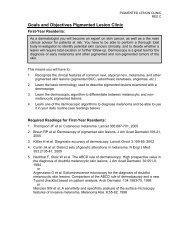UCSF Dermatology Residency Handbook - Dermatology - University ...
UCSF Dermatology Residency Handbook - Dermatology - University ...
UCSF Dermatology Residency Handbook - Dermatology - University ...
Create successful ePaper yourself
Turn your PDF publications into a flip-book with our unique Google optimized e-Paper software.
RESIDENCY HANDBOOK 2010-2011<br />
as well as the ability to call effectively on other resources in the system to provide<br />
optimal health care.<br />
2) The Department of <strong>Dermatology</strong> evaluates its residents using a variety of tools to<br />
assess performance in the six competency areas:<br />
(b) Evaluation of Resident Live Performance, once yearly, performed in the<br />
resident’s continuity clinic<br />
(b) Chart Stimulated Recall<br />
(b) Record Review<br />
(b) American Board of <strong>Dermatology</strong> In-Training Exam, once yearly<br />
(b) 360 degree Evaluations of Residents<br />
(i) All full-time teaching faculty evaluate residents they work with during a<br />
three-month period using competency-based questions on E-Value, an online<br />
evaluation system. These evaluations are made available to residents<br />
by the on-line E*value system.<br />
(ii) Residents are also evaluated by selected nursing staff, clerical staff, and<br />
academic staff<br />
(iii) On every clinic rotation (excluding Wards, Bw, Surgery, and Path) residents<br />
will engage in peer-to-peer feedback. This will be conducted in a one-onone<br />
format with each resident based at the same site for the month. At the<br />
start of the rotation, residents will delineate what they wish to improve in the<br />
current month and what their expectations are for their co-residents. At the<br />
end of the rotation, self-reflection and an assessment of their co-residents<br />
will occur, and at least one suggestion for improvement will be given.<br />
Midpoint feedback about progress with regards to these goals is optional.<br />
At quarterly resident meetings, residents will complete a written selfreflection<br />
that details what they have learned from the previous quarter’s<br />
peer-to-peer feedback, and their specific plan to improve on these items in<br />
the coming quarter.<br />
B) Formal Program Director Evaluations<br />
1) The program director meets with individual residents for formal evaluations twice per<br />
academic year.<br />
2) First year residents will be evaluated after approximately four months of residency.<br />
3) The year-end evaluation for each resident is sent to the American Board of<br />
<strong>Dermatology</strong>.<br />
(b) Third year residents must also submit the ABD’s surgical log form to be sent in<br />
with their final evaluation.<br />
C) Filing of Evaluations<br />
1) All evaluations are kept in resident portfolios in the academic office. Residents may<br />
request an appointment with the program director to review their portfolio.<br />
VIII) Moonlighting<br />
A) Introduction<br />
1) Resident input was solicited in the creation of this policy. This policy and necessary<br />
forms were approved by the <strong>UCSF</strong> <strong>Dermatology</strong> Residents, Program Director and<br />
Faculty in December, 2004.<br />
2) <strong>Dermatology</strong> Residents are not required to moonlight, but are permitted to moonlight<br />
both internally and externally under certain circumstances.<br />
B) Resident Responsibility<br />
19


